Infrared light therapy boosts your athletic recovery by triggering powerful cellular responses in your muscles. When you use this therapy, it penetrates deep into your tissue, stimulating your mitochondria to produce more ATP (cellular energy) while increasing blood flow and oxygen delivery. You'll experience reduced inflammation and muscle soreness as the light therapy activates your body's natural healing processes. It works by dilating blood vessels, clearing metabolic waste, and promoting faster cell regeneration. Plus, it helps release endorphins for natural pain relief. The science behind this recovery method reveals even more impressive benefits for athletes seeking peak performance.
Understanding Infrared Light Therapy

How does a technology that harnesses the power of invisible light help athletes recover faster?
Infrared light therapy penetrates deep into your skin using specific wavelengths (700-1200 nm) to stimulate cellular processes and enhance your body's natural healing abilities. This non-invasive treatment works by targeting your cells' mitochondria, boosting ATP production, and improving overall cellular function. These healing rays can reach up to 7 centimeters deep into your body's tissues.
When you expose your muscles to infrared light, you're activating a process called photobiomodulation (PBM). The light is absorbed by cytochrome c oxidase in your mitochondria, which triggers increased energy production and reduces oxidative stress.
You'll experience enhanced blood flow to your muscles, ensuring they receive more oxygen and nutrients for ideal recovery.
You can use infrared light therapy before workouts to prime your muscles for performance and after training to speed up recovery. It's particularly effective at reducing muscle soreness, decreasing inflammation, and accelerating soft tissue repair.
The therapy's ability to boost cellular communication and regeneration makes it a valuable tool for athletes seeking faster recovery times and improved performance. Whether you're dealing with chronic pain or looking to enhance your athletic output, infrared light therapy offers a science-backed approach to recovery.
Cellular Response to Light Treatment
Your cells respond remarkably to infrared light therapy through multiple biological mechanisms that enhance recovery and performance. When infrared light penetrates your tissues, it stimulates the production of ATP (cellular energy) by activating your mitochondria's respiratory chain, giving your cells the power they need to function at their best and repair damage.
During treatment, your cells experience reduced oxidative stress as the therapy triggers antioxidant production, protecting them from damage. The light also modulates cytokine levels, helping to maintain a balanced immune response and decrease inflammation. Periodic exposure to high-intensity infrared light for just ten minutes per session has been shown to effectively reduce inflammation.
You'll benefit from enhanced intercellular communication, which improves muscle cell coordination and function.
What's particularly important for your athletic recovery is how infrared therapy affects inflammation pathways. It decreases the expression of inflammatory marker genes like IL-6 and TNF-alpha while reducing the TLR-4 dependent inflammatory response. This means you'll experience faster recovery and less muscle soreness.
The therapy also increases blood flow to treated areas, delivering more oxygen and nutrients to your recovering muscles. When used before workouts, it can boost performance, and when applied afterward, it accelerates muscle repair and reduces recovery time.
Deep Tissue Healing Mechanisms
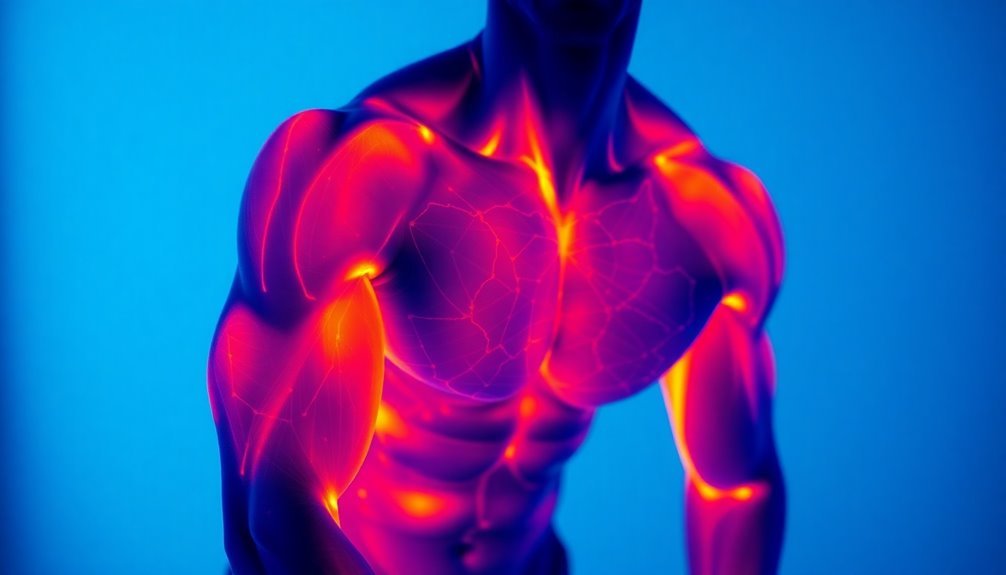
When you undergo infrared therapy, the light penetrates deep into your muscle tissues, triggering a cascade of cellular repair mechanisms that accelerate healing.
Your body responds to the infrared wavelengths by increasing blood circulation and delivering essential nutrients to damaged areas through expanded blood vessels.
Through this enhanced blood flow, you'll experience faster muscle recovery as oxygen-rich blood reaches deep tissue layers, supporting cellular regeneration and reducing inflammation.
Studies show that infrared light stimulates your body's natural production of ATP energy molecules, powering the cellular processes needed for tissue repair.
Cellular Repair Through Light
Light therapy's cellular repair mechanisms represent a groundbreaking advancement in athletic recovery science. When you expose your body to red and near-infrared light, it triggers a cascade of cellular responses that accelerate healing. Your cells' mitochondria become more active, producing increased levels of ATP – the energy currency that powers cellular repair.
The therapy works by stimulating your body's natural repair processes. It boosts the production of essential compounds like nitric oxide, which enhances blood flow to damaged tissues. Specific wavelengths between 600 to 1000 nanometers penetrate deep into tissue layers for optimal healing.
You'll experience increased cellular proliferation as the light activates growth factors like VEGF and FGF-2, promoting new blood vessel formation and tissue regeneration. Your body's natural healing response intensifies, with enhanced leukocyte activity clearing damaged cells more efficiently.
What's particularly remarkable is how the therapy affects your muscle tissue. It stimulates the growth of myofibroblasts and myofibrils while promoting muscle stem cell proliferation.
You'll notice faster recovery from muscle fatigue and damage, as the treatment accelerates cellular repair and regeneration. The increased blood circulation and oxygen transport to injured areas means you'll experience reduced inflammation and swelling, getting you back to peak performance more quickly.
Infrared's Deep Penetration Effect
Through the remarkable power of infrared wavelengths, healing energy penetrates several centimeters beneath the skin's surface to reach deep tissue structures.
Near-infrared wavelengths between 650nm and 900nm achieve maximum penetration, targeting tissues that traditional healing methods can't effectively reach.
When you undergo infrared therapy, you'll experience healing that works from the inside out, as the light triggers photobiological responses in your internal tissues.
Your body responds to infrared's deep penetration in four key ways:
- Breaking apart water clusters in your blood, which immediately enhances circulation and oxygen delivery to damaged tissues
- Activating cellular repair mechanisms several layers below the skin's surface
- Stimulating internal healing responses in joints, muscles, and connective tissues
- Triggering deep tissue regeneration through enhanced cellular activity
This deep-reaching capability makes infrared therapy particularly effective for athletic recovery. You'll benefit from improved blood flow and cellular regeneration at depths where muscle strains, joint inflammation, and tissue damage typically occur. The mitochondrial ATP production increases significantly during treatment, providing more energy for faster healing.
The therapy's ability to penetrate beyond surface level guarantees that healing occurs where you need it most.
Enhanced Blood Flow Mechanics
Infrared therapy revolutionizes blood flow mechanics in deep tissue healing by utilizing infrared light to penetrate your tissues, triggering the release of nitric oxide. This release causes your blood vessels to dilate, leading to immediate dilation and enhanced local circulation, particularly in areas where blood flow is compromised. Regular 20-minute treatment sessions help maintain these circulatory benefits.
The increased blood flow delivers more oxygen and glucose to your cells, powering up their energy production through the Krebs Cycle. Your mitochondria respond to infrared light by producing more ATP, which fuels cellular repair and regeneration.
You'll also experience increased production of growth factors like VEGF and FGF-2, which promote tissue healing.
What makes this process particularly effective for athletic recovery is its thorough approach to healing. As your circulation improves, you'll notice reduced inflammation and faster muscle recovery. The therapy's non-invasive nature means you won't face any downtime, and you'll likely experience better sleep quality, which further supports your body's recovery process.
When used regularly, infrared therapy can lead to long-term improvements in your vascular health and overall physical condition, making it an invaluable tool for athletes seeking enhanced recovery and performance optimization.
Pre-Workout Light Benefits
Pre-workout infrared therapy has emerged as a game-changing preparation strategy for athletes seeking peak performance. When you expose your body to infrared light before exercise, you'll experience enhanced blood flow and increased oxygenation to your muscles, setting the stage for top-notch performance. The moderate temperature exposure around 110°F ensures optimal benefits without overheating.
This preparation method doesn't just improve your physical readiness; it also puts you in an ideal mental state for your upcoming workout.
Here's what you'll gain from pre-workout light therapy:
- You'll notice improved muscle strength and endurance, as the therapy increases cellular energy production and reduces early fatigue
- Your risk of injury drops substantially because the light prepares your joints and tissues for intense activity
- You'll experience better aerobic capacity and extended time-to-exhaustion during your workouts
- Your muscles will be more resilient to damage and inflammation, reducing your chances of developing DOMS
The therapy's ability to enhance both physical and mental preparation can't be overlooked. You'll enter your workout with increased focus, reduced anxiety, and muscles that are properly warmed up and ready for action.
This thorough preparation translates to better performance and reduced recovery time.
Post-Exercise Recovery Solutions
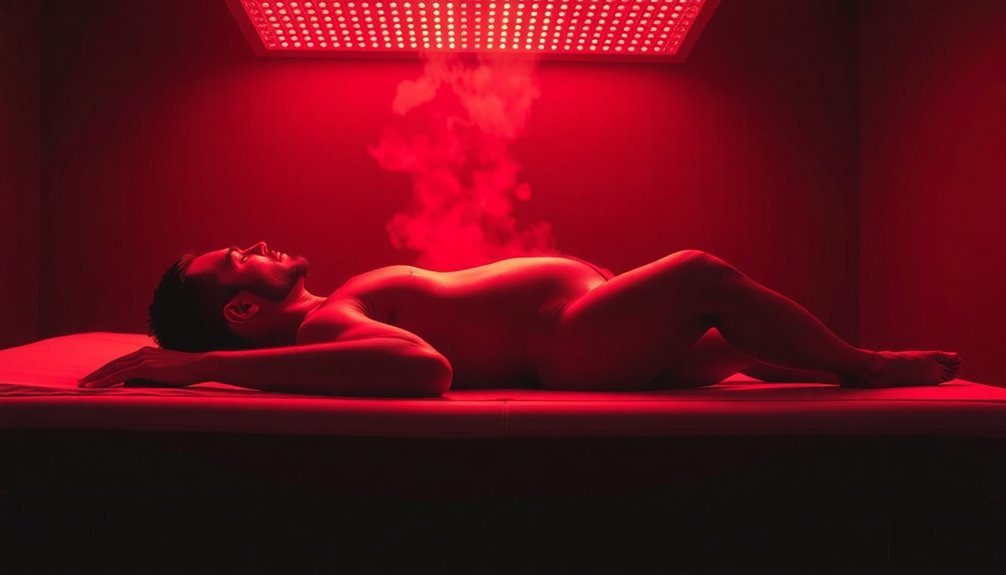
You'll find immediate relief from muscle pain through infrared therapy's deep-penetrating properties, which work alongside traditional heat therapy but offer enhanced cellular benefits.
Your recovery window becomes more efficient when you combine infrared treatments with proper nutrition timing and hydration within 30 minutes post-workout.
While heat therapy relaxes muscles at the surface level, infrared light's ability to stimulate ATP production and increase blood flow provides deeper, more thorough recovery benefits. Consider incorporating static stretches during your post-infrared session to further enhance flexibility and prevent muscle soreness.
Quick Muscle Pain Relief
Athletes seeking fast relief from post-workout muscle pain have found a powerful ally in infrared therapy. Using low-intensity light wavelengths between 700 and 1,000 nanometers, this therapy penetrates deep into your muscle tissue to trigger healing at the cellular level.
You'll experience reduced inflammation and accelerated recovery as the infrared light stimulates your body's production of nitric oxide, a compound that relaxes arteries and fights harmful free radicals.
When you undergo infrared therapy, you'll notice four key benefits:
- Enhanced blood circulation that delivers essential nutrients and oxygen to damaged tissues
- Increased production of endorphins, your body's natural painkillers
- Reduced inflammation in specific target areas like sore muscles and joints
- Improved mobility, especially in areas prone to stiffness
Unlike traditional recovery methods such as massage or cold-water immersion, infrared therapy offers a non-invasive solution that's easy to apply. You won't need specialized equipment or labor-intensive applications.
Instead, you'll get targeted relief that works particularly well for chronic conditions like arthritis and fibromyalgia, while also addressing acute post-exercise soreness and DOMS.
Optimizing Recovery Time Windows
During the critical hours following intense exercise, your body enters distinct recovery phases that require specific interventions for ideal healing.
In the immediate 0-2 hour window, you'll need to focus on essential recovery practices like consuming 20-30 grams of protein, proper hydration, and light stretching to jumpstart the healing process.
As you move into the 2-24 hour phase, you'll benefit most from combining active recovery techniques with therapeutic interventions. You can alternate between hot and cold hydrotherapy, take Epsom salt baths, or engage in light exercise to maintain blood flow to recovering muscles.
The 24-48 hour window is where infrared therapy shows its greatest potential. You'll want to incorporate both red and near-infrared light therapy to accelerate healing and reduce inflammation. Far-infrared therapy is particularly effective during this phase, as it penetrates deep into tissue to promote repair and decrease pain.
For maximum results, apply heat therapy in 15-20 minute sessions and consider using infrared-emitting garments to maintain consistent therapeutic benefits throughout your recovery period.
Heat vs. Light Benefits
While both heat and light therapy offer powerful recovery benefits, understanding their distinct advantages helps you choose the most effective treatment for post-exercise healing.
Heat therapy excels at immediate post-workout recovery by increasing blood flow, delivering essential nutrients to tired muscles, and promoting flexibility. Light therapy, on the other hand, specializes in cellular regeneration and tissue repair, making it particularly effective for injury recovery and long-term muscle health.
You'll notice distinct benefits with each treatment method:
- Heat therapy relaxes muscles immediately after exercise, preventing elastic tissue damage and maintaining strength levels.
- Light therapy stimulates mitochondrial function and cellular repair, accelerating your body's natural healing processes.
- Heat application works best for immediate soreness relief and flexibility improvement.
- Light therapy proves superior for long-term tissue regeneration and injury recovery.
When you combine these therapies through infrared treatment, you'll get the best of both worlds. Infrared therapy delivers deep-penetrating heat while simultaneously providing light therapy benefits, enhancing circulation, boosting metabolism, and accelerating muscle recovery.
This dual-action approach makes infrared therapy particularly effective for athletes seeking thorough recovery solutions.
Blood Flow Enhancement
Harnessing the power of infrared light creates remarkable improvements in blood circulation throughout the body. When you expose your muscles to infrared therapy, blood vessels dilate, allowing more blood to flow through previously restricted areas.
This enhanced circulation means your cells receive better oxygen and nutrient delivery exactly where they're needed most.
You'll benefit from infrared light's ability to penetrate deep into your tissues, where it breaks apart water clusters in your blood and expands the smallest blood vessels. This microscopic improvement in blood flow efficiency helps your body deliver more red and white blood cells to areas that need repair, reducing inflammation and accelerating healing.
The therapy stimulates your body's production of nitric oxide, which further enhances blood vessel dilation and oxygen delivery.
As an athlete, you'll notice the difference in your recovery as improved circulation helps flush out metabolic waste products while simultaneously delivering essential nutrients to your muscles. This dual action of waste removal and nutrient delivery makes infrared therapy particularly effective for supporting intensive training sessions and reducing post-workout muscle soreness.
Muscle Repair Science

The scientific mechanisms behind infrared therapy's muscle repair benefits are both fascinating and well-documented. When infrared light penetrates your muscle tissue, it triggers a cascade of cellular responses that accelerate healing and recovery. Your muscle cells' mitochondria absorb this light energy, leading to increased production of ATP – your body's cellular energy currency.
This enhanced cellular activity sets off several key processes that drive muscle repair:
- Your cells experience a surge in ATP production, giving them the energy needed to repair damaged tissue and regenerate new muscle fibers more efficiently.
- Your blood vessels dilate due to increased nitric oxide production, delivering more oxygen and nutrients to recovering muscles.
- Your inflammatory response becomes more regulated through cytokine modulation, reducing excess inflammation while maintaining necessary healing processes.
- Your oxidative stress levels decrease as infrared radiation stimulates protective mechanisms within your cells.
These biological responses work together to reduce muscle soreness by up to 60% and decrease markers of muscle damage, like creatine kinase, by up to 89%. The result is faster recovery times and enhanced muscle repair, allowing you to return to training sooner while maintaining peak performance levels.
Pain Management Through Light
Your body responds to infrared light therapy by blocking pain signals and releasing endorphins, which work together to provide significant relief from athletic discomfort.
The therapy's ability to enhance cellular energy production accelerates your body's natural healing processes, reducing the time you'll spend dealing with injury-related pain.
Through improved circulation and reduced inflammation at the cellular level, you'll experience faster recovery times while managing both acute and chronic pain more effectively.
Light Blocks Pain Signals
Modern infrared therapy disrupts pain signals through multiple pathways, offering athletes a drug-free approach to pain management. When you're exposed to infrared light, your body responds by activating several pain-blocking mechanisms that work together to reduce discomfort and accelerate healing.
At a cellular level, infrared light penetrates deep into your tissues, reaching muscles, nerves, and bones. This penetration triggers a cascade of biological responses that effectively block pain signals from reaching your brain:
- Your body releases endorphins, natural painkillers that bind to opioid receptors in your nervous system, blocking pain transmission at the spinal cord.
- Infrared wavelengths between 700-1,000 nanometers stimulate mitochondrial respiration, enhancing cellular energy production and oxygen delivery to damaged tissues.
- The therapy increases nitric oxide release, which improves blood circulation and helps deliver essential nutrients to injured areas.
- Your inflammatory response is regulated through balanced cytokine production, reducing swelling and associated pain.
These mechanisms work along your nociceptive pathways, affecting both A-delta and C-fiber nerve transmissions. By targeting multiple pain pathways simultaneously, infrared therapy provides extensive pain relief while supporting your body's natural healing processes.
Cellular Healing Reduces Discomfort
When cellular healing mechanisms activate under infrared light exposure, your body's natural pain management systems kick into high gear. The treatment triggers increased blood flow to damaged areas, delivering essential oxygen and nutrients that your cells need for repair.
This boost in circulation helps reduce inflammation and muscle soreness while stimulating the production of endorphins – your body's natural painkillers.
You'll experience relief as infrared therapy enhances cellular activity, promoting tissue regeneration and collagen production. This process directly targets the source of discomfort by supporting your body's natural healing abilities.
The therapy works at a deeper level, triggering metabolic events that help manage chronic pain conditions and reduce oxidative stress.
As your cells respond to the infrared light, they become more efficient at repairing damage and reducing inflammation. You'll notice improved muscle strength and reduced fatigue as the therapy accelerates your recovery process.
The treatment's ability to enhance cellular function means you won't just mask pain – you'll address its root cause through improved tissue repair and reduced inflammation, leading to longer-lasting relief and better athletic performance.
Inflammation Control Methods
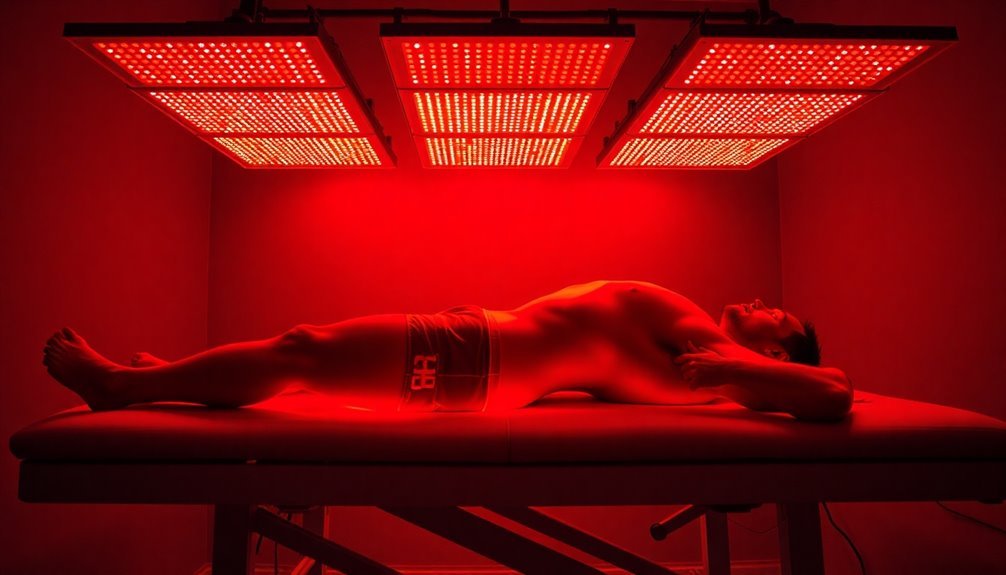
Athletes seeking effective inflammation control have multiple evidence-backed methods at their disposal. Infrared therapy stands out as a powerful tool, penetrating deep into tissues to boost circulation and accelerate the removal of inflammatory waste products.
When you combine this therapy with other proven approaches, you'll create an extensive strategy for managing inflammation during recovery.
Consider these essential inflammation control methods:
- Adopt an anti-inflammatory diet rich in omega-3s from salmon, tuna, and walnuts while avoiding processed foods and excessive omega-6 fats.
- Balance your training with adequate rest periods, incorporating light movement activities like swimming or gentle yoga between intense sessions.
- Use infrared therapy sessions to enhance cellular repair and reduce pain signals in damaged tissues.
- Prioritize whole food solutions over supplements, though tart cherry juice shows promise for reducing inflammatory markers.
Performance Optimization Strategies
Building on the foundation of infrared therapy's cellular benefits, a meticulous performance enhancement strategy integrates multiple approaches to maximize athletic potential. You'll want to focus on both pre-workout preparation and post-exercise recovery to achieve top results.
By applying red light therapy before your training sessions, you'll boost ATP production and prime your muscles for intense activity.
To enhance your performance, you should implement a systematic approach that combines targeted treatments with thorough recovery protocols. You can enhance your endurance by using near-infrared therapy regularly, which increases ATP production and improves energy efficiency at the cellular level. This boost in energy production directly translates to better stamina and reduced muscle fatigue during prolonged activities.
For best results, you'll need to apply light therapy both locally and systemically. Target specific muscle groups that need attention while also using broader applications to support overall recovery.
Recovery Time Acceleration
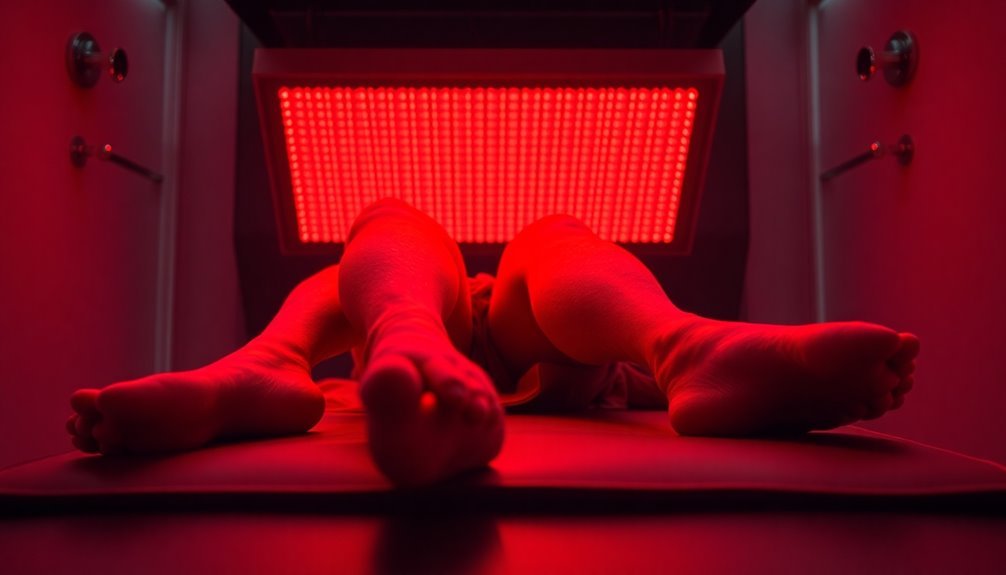
Through consistent infrared therapy applications, you'll experience substantially reduced recovery times between training sessions. The therapy works by promoting tissue repair, reducing inflammation, and enhancing blood flow to damaged muscles.
You'll notice a significant decrease in delayed onset muscle soreness (DOMS), allowing you to maintain a more rigorous training schedule without risking overtraining.
When you're dealing with injuries, infrared therapy accelerates healing by stimulating cellular repair and reducing pain markers. The treatment enhances mitochondrial activity, which boosts muscle function and endurance during your recovery phase.
For ideal results, you'll want to follow these evidence-based timing guidelines:
- Pre-workout: Apply for 5-10 minutes per muscle group to prepare tissues
- Post-workout: Dedicate 10-20 minutes per muscle group for repair
- Injury treatment: Use 15-30 minutes per session, 3-4 times weekly
- Maintenance: Position yourself 6-12 inches from the light source
Clinical studies support these protocols, showing that infrared therapy safely reduces recovery times while improving muscle strength. You'll find that consistent application helps you return to training sooner and potentially stronger than before your injury.
Elite Athletes Success Stories
Professional success stories strongly validate infrared therapy's effectiveness in athletic recovery. You'll find compelling evidence in how NFL legend Tom Brady attributes his remarkable career longevity partly to regular infrared sauna sessions. Similarly, tennis champion Serena Williams relies on infrared treatments to manage muscle soreness and speed up her recovery between matches.
CrossFit athletes have particularly embraced this technology, with notable success stories from multiple competitors. Travis Mayer has integrated the MOVE+ Pro red light therapy device into his daily routine, experiencing significant improvements in recovery time.
Sara Sigmundsdóttir found the therapy particularly valuable in managing swelling and rebuilding confidence after injuries. Sam Dancer's recovery from a full bicep rupture was expedited through strategic use of the MOVE+ Pro device.
You'll notice these athletes don't just use infrared therapy for recovery alone. They're leveraging its multiple benefits, including enhanced sleep quality, improved immune function, and increased endurance capacity.
The therapy's ability to reduce stress and promote detoxification has made it an invaluable tool in their training regimens, contributing to sustained peak performance and extended career spans.
Frequently Asked Questions
Can Pregnant Women Safely Use Infrared Therapy for Muscle Recovery?
You can safely use infrared therapy while pregnant for muscle recovery, but you'll need your doctor's approval first. It's non-invasive and helps reduce inflammation, though it's best to proceed with caution.
Does Infrared Therapy Interact With Prescription Medications or Supplements?
Yes, you'll need to be cautious with certain medications. Don't use infrared therapy if you're taking Gold 50 or Ridaura, and wait 5 days after stopping medications like Plaquenil or Azathioprine before treatment.
How Long Should You Wait After Eating Before Using Infrared Therapy?
While there's no specific research on post-meal waiting times for infrared therapy, you'll want to wait 1-2 hours after eating, similar to exercise guidelines, to guarantee comfortable treatment and ideal blood flow.
Will Infrared Therapy Cause Dehydration During Intense Training Periods?
You won't experience significant dehydration with infrared therapy during training, as it uses lower temperatures than traditional saunas. Just stay hydrated before and after sessions to maintain peak performance levels.
Can Infrared Therapy Help Reduce Delayed Onset Muscle Soreness in Beginners?
Yes, you'll find infrared therapy very effective for DOMS. It'll reduce your muscle soreness by improving blood flow, decreasing inflammation, and speeding up recovery through deep tissue penetration and enhanced cellular healing.
In Summary
You've learned how infrared therapy works to enhance your athletic recovery through cellular repair, reduced inflammation, and improved blood flow. Whether you're using it before workouts to prep muscles or after training to speed healing, you'll find this technology offers proven benefits. Start incorporating infrared therapy into your recovery routine, and you'll likely notice faster bounce-back times and better overall performance.

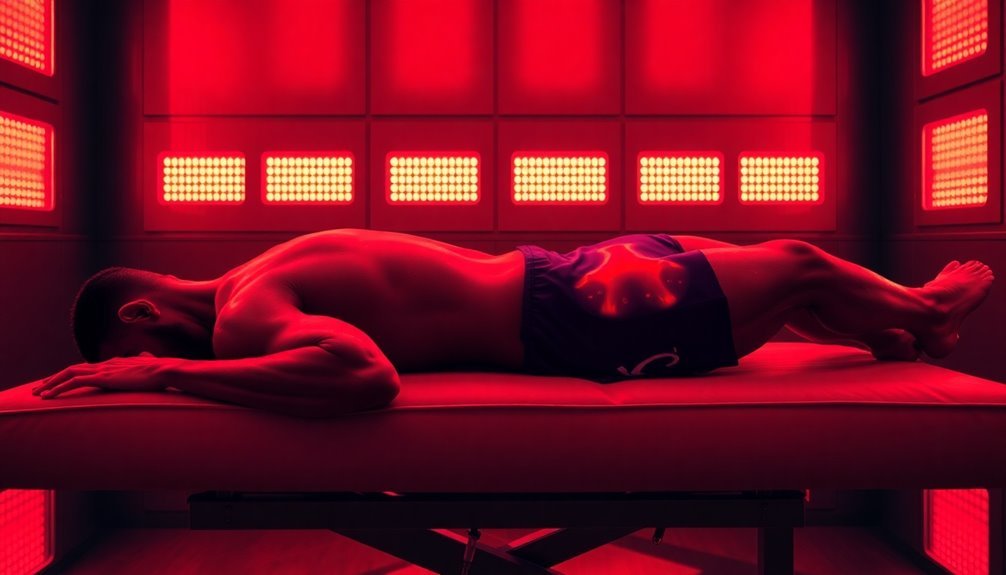



Leave a Reply